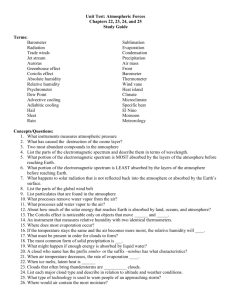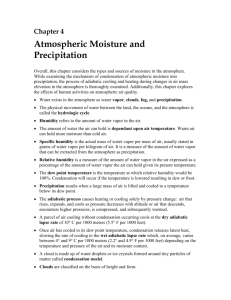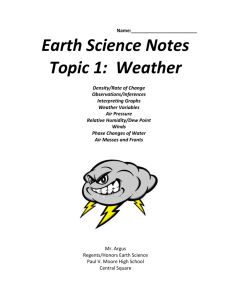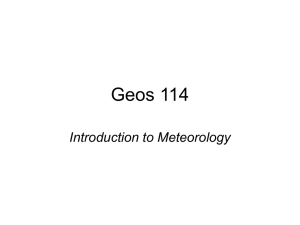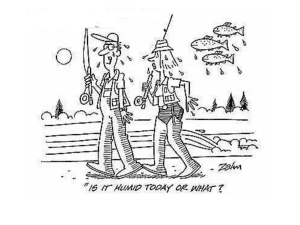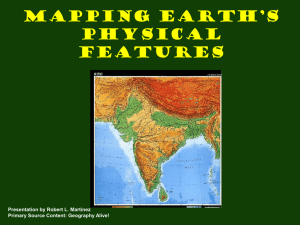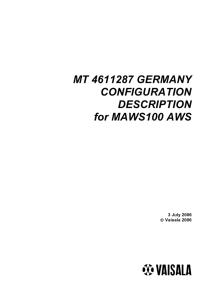Sample Unit of Study - New York Science Teacher
advertisement
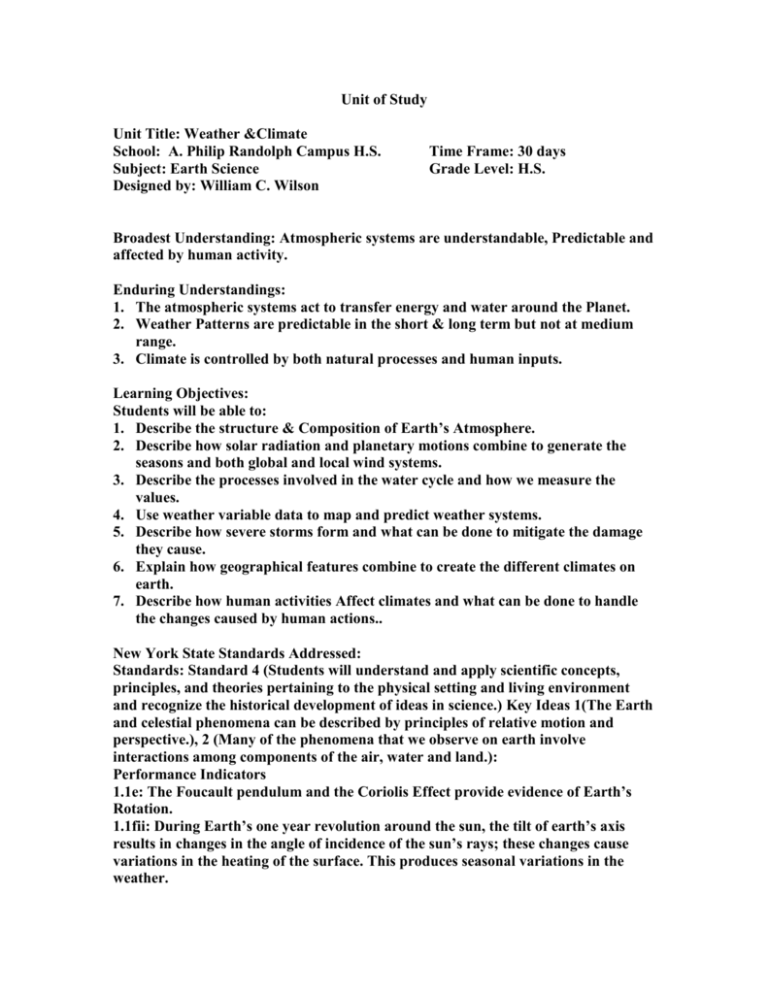
Unit of Study Unit Title: Weather &Climate School: A. Philip Randolph Campus H.S. Subject: Earth Science Designed by: William C. Wilson Time Frame: 30 days Grade Level: H.S. Broadest Understanding: Atmospheric systems are understandable, Predictable and affected by human activity. Enduring Understandings: 1. The atmospheric systems act to transfer energy and water around the Planet. 2. Weather Patterns are predictable in the short & long term but not at medium range. 3. Climate is controlled by both natural processes and human inputs. Learning Objectives: Students will be able to: 1. Describe the structure & Composition of Earth’s Atmosphere. 2. Describe how solar radiation and planetary motions combine to generate the seasons and both global and local wind systems. 3. Describe the processes involved in the water cycle and how we measure the values. 4. Use weather variable data to map and predict weather systems. 5. Describe how severe storms form and what can be done to mitigate the damage they cause. 6. Explain how geographical features combine to create the different climates on earth. 7. Describe how human activities Affect climates and what can be done to handle the changes caused by human actions.. New York State Standards Addressed: Standards: Standard 4 (Students will understand and apply scientific concepts, principles, and theories pertaining to the physical setting and living environment and recognize the historical development of ideas in science.) Key Ideas 1(The Earth and celestial phenomena can be described by principles of relative motion and perspective.), 2 (Many of the phenomena that we observe on earth involve interactions among components of the air, water and land.): Performance Indicators 1.1e: The Foucault pendulum and the Coriolis Effect provide evidence of Earth’s Rotation. 1.1fii: During Earth’s one year revolution around the sun, the tilt of earth’s axis results in changes in the angle of incidence of the sun’s rays; these changes cause variations in the heating of the surface. This produces seasonal variations in the weather. 1.1h: The sun’s apparent path through the sky varies with latitude and season. 1.2e: Earth’s early atmosphere formed as a result of the outgassing of water vapor, carbon dioxide, nitrogen, and lesser amounts of other gasses from its interior. 1.2gi:Earth has continuously recycled its water since the ocean formed. This recycling is called the water (Hydrologic) cycle. Water is returned from the atmosphere to Earth’s surface by precipitation. Water returns to the atmosphere by evaporation. 2.1a: Earth systems have internal and external sources of energy, both of which create heat. 2.1b: The transfer of heat energy within the atmosphere, hydrosphere, and solid earth results in the formation of regions of different densities. These density differences result in motion. 2.1c: Weather patterns become evident when weather variables are observed, measured, and recorded. These variables include air temperature, air pressure, relative humidity, dew point, precipitation (rain, snow, sleet, hail), wind speed and direction and cloud cover. 2.1d:Weather variables are measured using instruments such as thermometers, barometers, psychrometers, precipitation gauges, anemometers, and wind vanes. 2.1e: Weather variables are interrelated; for example: temperature and humidity affect air pressure and probability of precipitation; air pressure gradient controls wind speed. 2.1f: Air temperature, dew point, cloud formation, and precipitation are affected by the expansion and contraction of air due to vertical atmospheric movements. 2.1g: Weather variables can be represented in a variety of formats including radar, satellite images, station models, weather maps and computer models. 2.1h: Atmospheric moisture, temperature and pressure distributions; jet streams, wind; air masses and frontal boundaries; and the movement of cyclonic systems and associated storms occur in observable patterns. Loss of property, personal injury, and loss of life can be reduced by effective emergency planning/preparedness. 2.1i: Seasonal changes can be explained using concepts of density and heat energy. These changes include the shifting of global temperature zones, the shifting of planetary wind and ocean current patterns, the occurrence of hurricanes, monsoons, flooding, and severe weather. Assessments: 1. 2 sub-unit tests consisting of 25-30 multiple choice Regent’s style questions and 3-5 extended concept questions. 2. 7 laboratory activities. Key knowledge and skills gained: Students will be able to: 1. Describe the structure and composition of the atmosphere. 2. Describe how we know the Earth rotates and revolves. 3. Describe how insolation angle, duration and surface type affect the heating of the planet. 4. Describe how local and global wind belts are formed by this differential heating. 5. Describe the processes of the water cycle and how different types of precipitation form. 6. Explain and determine relative humidity and dew point. 7. Plot and read weather station models and weather station instruments. 8. Describe how air masses form and how they interact to create fronts. 9. Describe and map the occurrence of cyclonic systems and the storms they generate in different locations. 10. Explain how Hurricanes, Tornadoes, Blizzards (Nor’easters), and storms are related. 11. Use commonly observable weather variables to predict weather over a few days time. 12. Describe the factors that interact to create the Earth’s different major climate zones. 13. Use these factors to determine the climates on a model continent. 14. Explain how human activities are affecting the global climate patterns and what can be done to minimize these effects. 15. Describe how good planning and preparedness can reduce the impact of severe storms and climate changes. Learning Experiences: 1. Aim: Lab 9: Structure & Composition of the Atmosphere Activity: Lab 9: Structure & Composition of the Atmosphere 2. Aim: How are the seasons created? (I) Activity: modeling Earth’s motions. 3. Aim: How are the seasons created? (II) Activity: Graphing sunrise, sunset and daily temperatures. 4. Aim: How are the seasons created? (III) Activity: modeling solar altitudes and temperatures 5. Aim: How are winds created? Activity: Convection and wind generation 6. Aim: How does the angle of the sun and the type of surface the sun’s rays hit affect the local temperature and winds? Activity: Lab: Angle of Insolation and Effect of Surfaces on Heating. 7. Aim: How do the planetary wind belts form? Activity: Mapping Planetary Winds 8. Aim: How do Local winds form? Activity: Diagramming Local Wind Systems 9. Aim: How do we Measure & Record Atmospheric properties? Activity: Station plots: temp. Pressure, Winds 10. Aim: How does Earth’s rotation Affect Winds? Activity: Lab: Coriolis Effect 11. Aim: How does water move through Earth Systems (Water cycle Review)? Activity: Diagramming the Water Cycle 12. Aim: How is Relative Humidity & Dew Point Temp. Controlled? Activity: Evaporation &Condensation in the Atmosphere (cloud chambers) 13. Aim: How do different types of precipitation form? Activity: Diagramming precipitation types (rain, sleet, snow, hail, glaze) 14. Aim: How are Relative Humidity and Dew point Determined? Activity: Lab: Relative Humidity & Dew Point 15. Aim: How does terraine affect humidity and precipitation? Activity: Lake effect snows and fogs 16. Aim: How are moisture factors measured and recorded? Activity: Station symbols plotting DP, RH, precip. & cloud cover 17. Aim: Sub-Unit test – weather variables Activity: sub-unit test – weather variables 18. Aim: How does altitude affect humidity (Adiabatic cooling)? Activity: Lab: Determining Cloud Base height 19. What are air masses and how do they form? Activity: mapping air mass source regions by properties 20. Aim: How do air masses interact (I: warm & cold Fronts)? Activity: Diagramming warm and cold fronts 21. Aim: How do air masses interact (I: stationary & occluded Fronts)? Activity: Diagramming stationary and occluded fronts 22. Aim: How do we use weather maps to predict the weather? Activity: reading weather maps and predicting the weather 23. Aim: How do different cyclonic storms form? Activity: Concept map: cyclonic storms 24. Aim: How do weather maps help us predict weather patterns? Activity: Lab: working with weather maps. 25. Aim: How is climate different from weather? Activity: Concept maps: weather & climate 26. Aim: What factors affect global climate? Activity: Diagramming the Greenhouse effect 27. Aim: What factors Affect local climates? Activity: Global climate map 28. Aim: What factors Affect local climates? (II) Activity: Diagramming Monsoons 29. Aim: What factors Affect local climates? (III) Activity: Lab: Mapping Climates on an sample continent 30. Aim: Sub-unit test: Weather & Climate Activity: Sub-unit test: Weather & Climate
